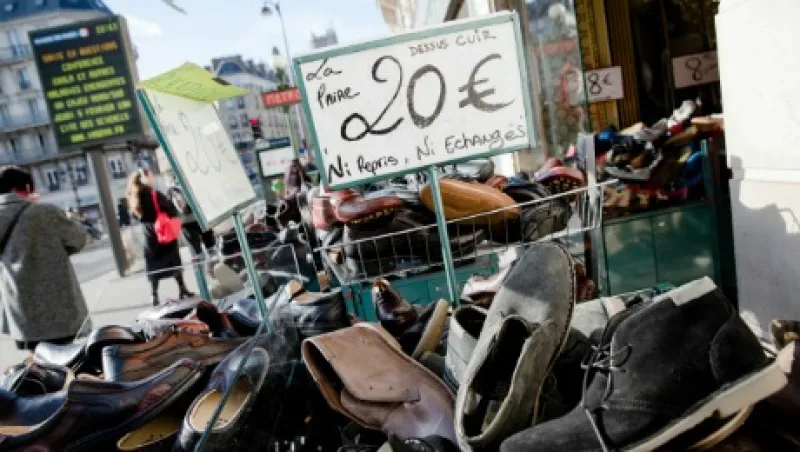The euro zone’s primary economies are diverging, if fourth-quarter 2014 GDP data, released today, is any indication. Coming in at a fairly robust seasonally adjusted 0.7 percent, German growth levels exceeded expectations, with the full-year pace reaching 1.6 percent. The story in France and Italy is more downbeat, however, with 0.1 percent and 0 percent respectively. Even with a flat reading, Italian data exceeded consensus forecasts. With private-sector lending markets showing the faint signals of greater liquidity and improving activity measures in many recovering peripheral economies, today’s news could be taken as a signal that while the situation remains troubled, Europe may at least have found a bottom. For sovereign debt markets, the question now will be if any recovery will be equally enjoyed by all members of if Germany will chart its own course.
Greek drama continues. In advance on Monday’s meeting with euro zone leaders, Greek Finance minister Yanis Varoufakis is spending the day in discussions with the troika — the European Commission, the European Central Bank and the International Monetary Fund. Earlier this week, the ECB’s Governing Council temporarily extended a liquidity facility for Greek banks, providing an extra week of funds. While Varoufakis insists that a debt swap is possible, German officials have continued to raise concerns over the precedent that may be set by allowing Greece to scrap austerity measures.
Rolls Royce posts earnings shortfall. In its fourth-quarter earnings statement, released today, London–headquartered automotive, aerospace and power systems manufacturer Rolls Royce guided forecasts for 2015 lower after reporting a full-year 6.1 percent contraction for 2014. A currency-hedge value markdown contributed to the disappointing figures. The company has recently executed a series of belt-tightening measures in its aerospace unit, including significant layoffs.
U.S. economic data on deck. Import and export prices for January are scheduled for release today, with low oil inputs expected to weigh on both measures. In light of the disappointing retail sales figures for January released yesterday, the University of Michigan initial sentiment index release for February, scheduled for release in the afternoon, will be a focus for consumer sentiment.
DAX achieves milestone. On the back of surprisingly strong fourth-quarter GDP, the Deutscher Aktienindex (DAX) traded above 11,000 for the first time this morning. Year to date, relative outperformance of the German economy and ECB easing measures have helped propel the index more than 10 percent higher.
Portfolio Perspective: Taking the Temperature of Loan ETFs — Bradley Rogoff, Barclays
The loan market traded up this week, along with high yield. The average price of loans in the Barclays Performing Loans Index is modestly higher week-over-week, up $0.35 to $97.40 through Thursday, and year-to-date returns hit the 1 percent mark on Wednesday. Despite steady performance for the asset class since mid-January, retail investors remain uninterested. Outflows of more than $5.5 billion have hit loan mutual funds and exchange-traded funds so far this year, piling on to the $21.7 billion in total outflows in 2014.
It seems long ago now, but loan ETFs once were growing exponentially. Amid rising rate concerns escalated by the taper tantrum in mid-2013, loan ETFs enjoyed staggeringly fast asset growth throughout the year. BKLN, the most prominent loan ETF, more than tripled in size from December 2012 to December 2013 and reached its peak assets under management of $7.4 billion last March. A month later, the outflows that have persisted to date began, and the asset base of loan ETFs simultaneously started to shrink. Outflows have sapped the funds of about 20 percent of their assets since the peak and their aggregate assets under management now stands at about $6.7 billion. Despite the persistent outflows, secondary trading volumes of the ETFs have remained steady. While volumes peaked during the taper talk of mid-2013, the 90-day rolling average of daily volumes in loan ETFs has since fluctuated in a steady range of between $75 million and $85 million.
Loan ETFs typically hold much more cash than high-yield ETFs. Two main factors influence that difference: longer settlement time for loan trades and the cash-only creation and redemption on which the funds rely to manage flows into and out of the product. That discrepancy in cash balances persists. Loan ETFs are holding an average of 5 percent cash, compared with an average of less than 1 percent for high-yield ETFs. The create-redeem process and long loan settlement times are unlikely to change in the near future, so the by-product of higher cash balances is likely to persist.
Retail interest in loans and, by extension, loan fund flows are correlated with rates expectations. As the likelihood of a rate hike by the Federal Reserve returns to the conversation after a strong jobs report last Friday, loan ETFs may soon stand to benefit. The shift is somewhat evident in fund flows already. While loan mutual funds continue to see steady outflows, ETFs have seen the outflow tide ebb and have taken in very small inflows — around $12 million — in the past two weeks. That said, the inflows may also be a result of the larger upside in loans, considering the lower average dollar price following the late-year sell-off.
Bradley Rogoff is head of credit strategy at Barclays in New York.






